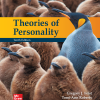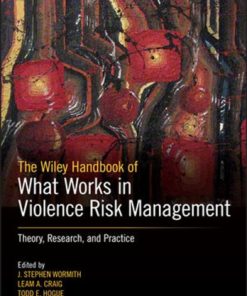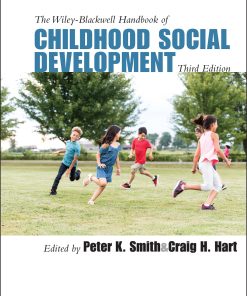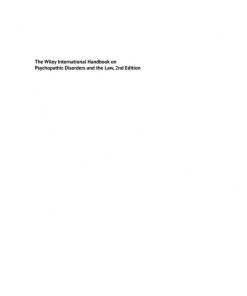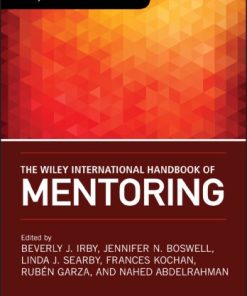The Wiley Blackwell Handbook of Bullying: A Comprehensive and International Review of Research and Intervention, Vol. 1 1st Edition Peter K. Smith
$50.00 Original price was: $50.00.$25.00Current price is: $25.00.
The Wiley Blackwell Handbook of Bullying: A Comprehensive and International Review of Research and Intervention, Vol. 1 1st Edition – Ebook Instant Download/Delivery ISBN(s): 9781118482711, 1118482719, 9781118482728, 1118482727

Product details:
- ISBN-10: 1118482719
- ISBN-13: 9781118482711
- Author: Peter K. Smith, James O’Higgins Norman
Explore the latest research and theory on bullying with this international reference from leading voices in the field The two-volume Wiley-Blackwell Handbook of Bullying delivers a comprehensive exploration of a wide range of research on bullying, broadly defined. School bullying is dealt with at length, but there is also coverage of college and workplace bullying and bullying within sports settings, prisons, families, and elder care residential homes. Containing contributions from leading scholars on five continents, the book summarizes the latest theories, findings, developmental aspects, and interventions relevant to bullying in a variety of settings. With up-to-date information on rapidly developing topics like sibling bullying, cyberbullying, bias-based bullying, migration and bullying, dating violence, and economic evaluation of bullying prevention programs, The Wiley-Blackwell Handbook of Bullying offers readers a complete view of a wide array of bullying behaviors. The insightful and up-to-date information contained within the two volumes is destined to become the standard reference for bullying-related research and theory. Readers will benefit from: Fulsome material covering research and practice conventions in countries and regions including Europe, North America, South America, Australasia, Japan, South Korea, India, Mainland China and Hong Kong, the Arab countries, and sub-Saharan Africa A comprehensive discussion on the correlates and outcomes of taking part in bullying, as well as being a victim of bullying An exploration of a variety of strategies to deal with bullying incidents, including proactive, reactive, and peer support approaches An analysis of different kinds of bullying, faith-based bullying, and disablist bullying, including racist and ethnic bullying, sexist and sexual bullying, and homophobic and transphobic bullying Perfect for postgraduate students in programs dealing with bullying in virtually any conceivable context, The Wiley-Blackwell Handbook of Bullying will also earn a place in the libraries of researchers and practitioners in fields as diverse as psychology, sociology, social work, medicine, criminology, child care, and elder studies.
Table contents:
Section One – Conceptual and Historical Issues
Chapter 1: Definitions of Bullying
Chapter 2: Origins of School Bullying Research
Chapter 3: The School Bullying Research Program: Why and How It Has Developed
Chapter 4: Critique of the Bullying Research Program
Chapter 5: Participant Roles in Bullying
Chapter 6: Types of Traditional (Offline) Bullying
Chapter 7: Types of Cyberbullying
Chapter 8: Teachers’ Attitudes Toward Bullying: What Do We Know, and Where Do We Go from Here?
Chapter 9: Why Do Bullies Bully? Motives for Bullying
Section Two – Measurement Issues
Chapter 10: Measurement Issues Relevant to Questionnaire Data
Chapter 11: Social Network Approaches to Bullying and Victimization
Chapter 12: A Peek Behind the Fence: Observational Methods 25 Years Later
Chapter 13: Measurement Issues Relevant to Qualitative Studies
Section Three – Bias or Identity Based Bullying
Chapter 14: Ethnicity-Based Bullying: Suggestions for Future Research on Classroom Ethnic Composition
Chapter 15: Bias Bullying Problems Among School Children: Sexual and Gender-Based Bullying, and Intersectional Considerations
Chapter 16: Bias Bullying: Sexual Orientation
Chapter 17: Transphobic Bullying
Chapter 18: Religious-Based Bullying: International Perspectives on What It Is and How to Address It
Chapter 19: Disablist Bullying
Chapter 20: Migration and Bullying
Section Four – Risk Factors
Chapter 21: Genetic and Epigenetic Factors in Bullying
Chapter 22: Neurobiological Factors of Bullying Victimization
Chapter 23: Personality Factors, Empathy, and Moral Disengagement in Bullying
Chapter 24: Parents and Bullying
Chapter 25: The Role of the Peer Group and Classroom Factors in Bullying Behavior
Chapter 26: School Factors with a Focus on Boarding Schools
Chapter 27: Communities and Neighborhoods as Contexts that Influence the Bully/Victim Dynamic
Chapter 28: Media Factors and Bullying
Chapter 29: Cultural Factors and Bullying
Chapter 30: Combating Workplace Bullying: Interventions and the Role of the Organization’s Ethical Infrastructure
Section Five – Outcomes of Bullying
Chapter 31: Bullying and Internalizing Symptoms
Chapter 32: Bullying and Externalizing Problems
Chapter 33: Understanding the Associations Between Bullying, Suicide, and Self-Harm
Chapter 34: School Bullying and Peer Victimization: Its Role in Students’ Academic Achievement
People also search:
The Wiley Blackwell Handbook of Bullying
the wiley blackwell handbook of judgment and decision making
the wiley-blackwell handbook of transpersonal psychology
the wiley handbook of eating disorders
the wiley blackwell anthology of african american literature
You may also like…
Business & Economics - Economics
Handbook of International Economics: International Trade Vol. 5 1st Edition
Relationships & Lifestyle - Psychological Self-Help
Uncategorized
Handbook of International Economics: International Macroeconomics, Vol. 6 Gita Gopinath
Psychology - Developmental Psychology
The Wiley-Blackwell Handbook of Childhood Social Development 3rd Edition
Uncategorized
Psychology - Clinical Psychology
The Wiley International Handbook on Psychopathic Disorders and the Law 1st Edition Alan R. Felthous
Education Studies & Teaching - School Education & Teaching
The Wiley international handbook of mentoring: paradigms, practices, programs, and possibilities
Religion & Spirituality - Religious Studies


